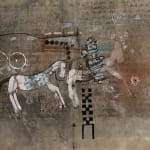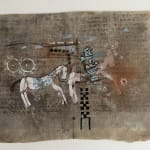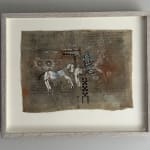


Skunder Boghossian Ethiopian, 1937-2003
Further images
Skunder Boghossian was born in 1937 during the Italian occupation of Ethiopia, to an Ethiopian mother and a father of Armenian descent. He is widely believed to be one of the founders of Ethiopian Modernism. In 1955 he went to London where he attended St Martins School of Art and Central School of Arts and Crafts, and then shortly after he moved to Paris in 1955/56 to begin at the Ecole des Beaux Arts, shortly after which he transferred to the Académie de la Grande Chaumire. Here he met Curt Coetz, Master of the Studio and André Breton. These, along with other Surrealist artists he met there, would have a substantial impact on him.
Skunder submerged himself in African Mythology, symbolism and iconography, developing a strong connection with spiritual powers of African ancestors which would be a source of inspiration for the rest of his life. It is what drew him initially to Surrealism and the representation of the subconscious. In 1965 MoMA purchased his work and he became the first African artist in their collection. Works of this period can be found in numerous other significant collections in the US and France.
After spending a decade in Europe Skunder returned to Ethiopia in 1966. While teaching at the Addis Fine Art school, he also travelled extensively throughout the country, immersing himself in the old cultures and traditions but also exploring cross cultural African contexts. At this time he developed an obsession with Magical scrolls made by Debteras which would feature heavily in his later work. The vellum was done in this period. Inspired by his travels the images show influences of the wall paintings found in the medieval Rock churches scattered around in the Tigrayan mountains in northern Ethiopia. It is also referencing the magnificent illuminated manuscripts that are the be found within these mountains and in museums worldwide. A popular theme in both manuscripts and wall paintings is saints and donors on top of magnificently adorned horses. The horses and their riders in these vellums seem to refer to this theme. The vellum he has used must have been part of one such manuscript albeit a minor one. You can faintly see traces of the ancient written Ge’ez language. The holes where the original manuscripts would have been bound are still there.
In 1969 he left Addis Ababa for the United States. From the start he actively participated with the civil rights movement. He joined the staff of Howard University in 1972 at the height of the Black Power Movement and actively participated in a culture of resistance, teaching painting alongside Jeff Donaldson, the founder of the Afri-Cobra movement. Skunder was drawn to the Africentric aesthetic vision that was designed to create imagery that reflects social responsibility and technical excellence. In his work he commented on social injustice and the black consciousness interwoven with references to African heritage and culture. Skunder never returned to his home in Ethiopia and stayed in the US until his death in 2003. Nonetheless he left a huge mark on Ethiopian modernism and continues to be an inspiration for many Ethiopian artists within the country and diaspora.
Join the mailing list
* denotes required fields
We will process the personal data you have supplied in accordance with our privacy policy (available on request). You can unsubscribe or change your preferences at any time by clicking the link in our emails.


